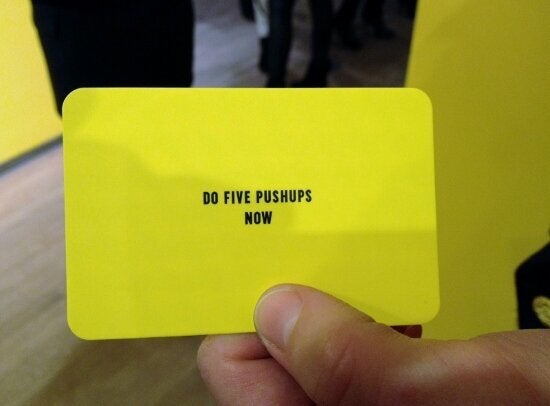

Stefan Sagmeister is bringing his happy to Toronto. The Austrian-born New York-based designer blends typography and imagery in inspired, moving, and sometimes quirky ways, perhaps most famous for his album cover work for Talking Heads, OK Go, and the Rolling Stones. Sagmeister has chosen to take his creativity in a new direction with his recently opened exhibition, "The Happy Show," an art installation that mirrors the premise and ideas of his soon to be released documentary "The Happy Film." The show tests the boundary between art and design, while allowing visitors the opportunity to delve deep into the mind of the man behind the work. With use of various interactive mediums such as canvas, print, infographics and videos, Sagmeister clearly depicts a story of a man in search of answers, and shares his personal experiences and knowledge he has on the topic via handwritten notes on the walls.
I had the opportunity to attend the opening night gala in early January, and Sagmeister himself was there to give us the grand tour. It was both an education and a pleasantry to hear him speak from the heart as he explained his stance on the subject at hand and answer any questions us media types had on the topic of serenity and joy. He coolly handled the inquiry of "what is the difference between happiness & joy" with great authority and presence and spoke solidly about the facts and numbers collected during the extensive data gathering phase of the project; although he does admit that he only included the research and stats he agreed with or liked in the show. Bias? Maybe. Super fun? Totally.
Here, a brief look into how I interpreted the exhibit, and the top six things I learned about all things cheerful, sunny, and full of delight:
1.Working out with a personal trainer the morning of an art gala can be hazardous to your health. Upon arrival at the show, each guest was guided by a massive arrow painted on the wall to "press the button." I pressed and received my direction for action at the event; a yellow playing card with the instructions "do five push-ups now." Just my luck. I learned that other cards pulled coaxed things such as "have someone at the show draw a picture of you," or "tell someone that their fly is open." All in good fun, and yes it made me smile.
2.Elephants not only never forget, but they make for great symbolism of the unconscious mind. I had never read this, but research psychologist Jonathan Haidt's description of the conscious (ego, awareness) as a small rider sitting atop a giant elephant (the unconscious, soul, spirit) is a super simple yet impactful comparison. He goes on to say that even as the rider struts along believing that he is in charge and can tell the elephant where to go, it is actually the elephant that truly runs the show, with deeper and more meaningful thoughts and plans. The rider can attempt to train the beast, but both will be better off if they simply work as a team.
3.When you think "I should do this," or "I should do that," do it. Universally, I think we can all relate to Sagmeister's statement that when we don't "follow through and actually do it, the uncompleted action creates a little nagging but otherwise empty space" in the mind. We also "miss out on the satisfying feeling that comes with the completion of a project." So why not just do it, friends?
4.The ancient Indian language Sanskrit contains 16 words for happiness. Did you know that? I am training to be a yoga teacher and I was unaware. German includes none. Hmm. To Sagmeister this begs the question, "Does this mean the Indians are happier? Or do they just know how to talk about it properly?"
5.How happy can you actually be? Well, according to Sagmeister's research, we all have a limited ability to get more joy flowing in our blood. Here's are the deets on our blissful breakdown:
a.50 per cent of our happiness is predetermined by genetics. Each of us is born with a pre-disposition to a certain level of happiness that is passed down to us from our folks. Just as I have blonde hair and strong bones, I also have a "happiness set-point." You have the same, only different thanks to your ma and pa's genetic makeup.
b.40 per cent of our joy is created via our intentional activities; the things we choose to partake in to fill out our lives. This makes sense. Anything you consciously choose to do can make you happier, or more blue. Try things like meditation, exercise, and socializing to give yourself a boost, or simply do whatever it is that brings you joy!
c.The remaining 10 per cent of our contentment arises from our life conditions, and can include factors such as age, sex, personal experiences, occupation, health, income, religious beliefs, marital status, and geographic factors. Sorry, not much we can do about some of these guys other than being grateful for what we have. A life! Breath! A soul!
6.And finally, be ballsy. Do more of the things you like to do, and less of those you don't. Period.
"The Happy Show" runs until March 3, 2013 at The Design Exchange, and "The Happy Film" is set to be released in the Fall of 2013. Check out Stefan speaking a bit more about his findings here.
